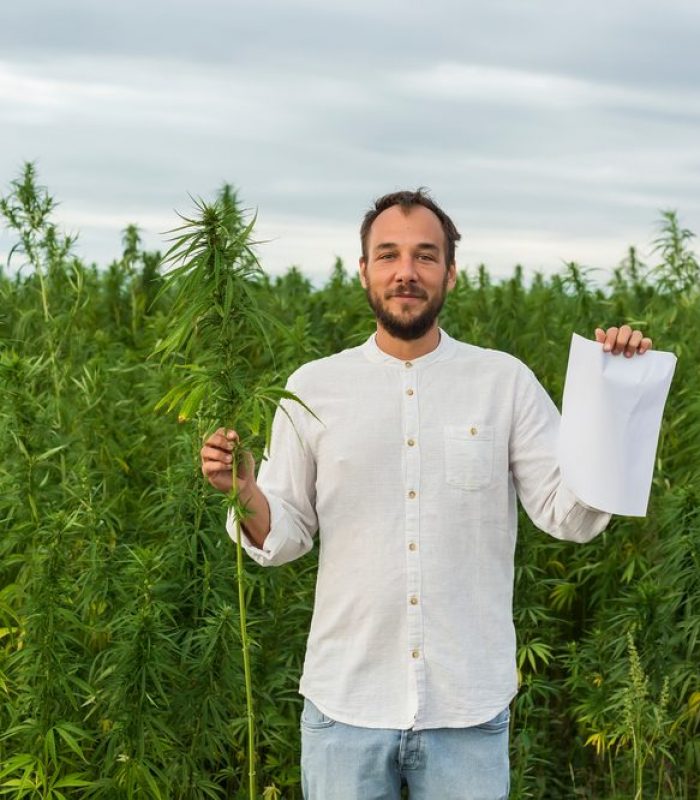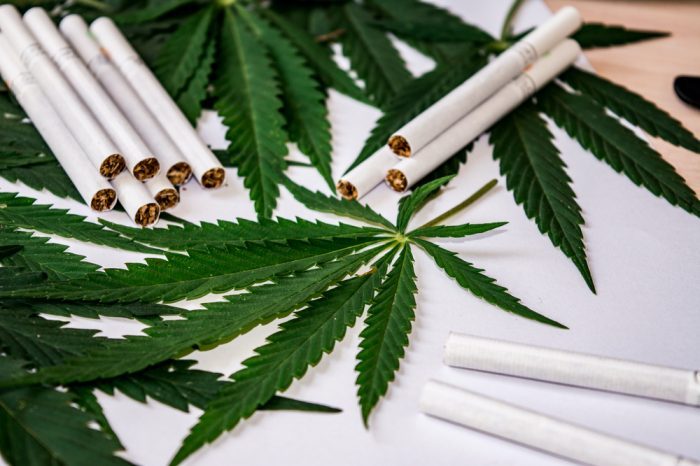Fields of hemp are going to change the world.
Thanks to decades of prohibition, hemp is both an ancient medicine and a new technology. A lot of people are well aware that George Washington and Thomas Jefferson both grew hemp; but far less know that it was fields of hemp that grew the British Empire. Less people know too, that hemp building materials helped repair Europe in the aftermath of the second world war. Thankfully, more and more people know that sustainable hemp is going to have a huge impact on our planet’s green future. Turns out hemp is a far more sustainable, and far more versatile, material than a lot of people imagined.
Here’s how hemp is going to change the world for the better.
Growing Sustainable Hemp For the Environment
The earth’s once balanced climate is in a state of disarray, and humans are in the midst of a dramatic shift towards greener technologies, as a result. Thankfully, we’re beginning to enter a time where we not only see the results of our CO2 emissions and single-use lifestyle, we’re coming into an era when we can actually do something about it. People have buying power, and large corporations are recognizing this and greening themselves up as a result.
Still, growing and producing some materials is far more detrimental to the environment than others. For example, the average consumer is still surrounded by single use plastics and non sustainable products. Thankfully, however, a huge number of these products have sustainable hemp substitutes; and knowledge of hemp as a sustainable replacement for many of these traditional products is only growing. Sustainable hemp plastics, hemp fabrics, hemp paper, and even hemp building supplies, are becoming more and more common by the day in North America. These products are coming about even faster following the passage of the 2018 Farm Bill, which legalized cannabis under 0.3 percent THC in most of the United States.
A lot of consumers aren’t aware what it actually is that makes hemp so sustainable, however. To answer that, here’s RxLeaf’s guide to why hemp could be a huge part in our planet’s sustainable future.
What Makes Hemp Sustainable?

Fields of Hemp Are The Perfect Carbon Sink
Aside from the multitude of products hemp turns into, it helps the environment as soon as it is planted. Firstly, hemp is the ideal “carbon sink.” A carbon sink is a forest, ocean, or other natural environment viewed in terms of its ability to absorb carbon dioxide from the atmosphere. Hemp plants mature in just 70 to 120 days. There’s more: by the hectare, the hemp plant actually absorbs CO2 much more efficiently than trees. This does not invalidate the extreme need to replenish the world’s diminishing forests. However, it underscores the importance of hemp as sustainable alternative to other traditional carbon sinks.
Water Sustainable Hemp
Even better than its CO2 absorption, is, perhaps, the significantly reduced amount of water hemp needs to grow. The widespread rumor that hemp needs “barely any” water to grow is no more than a rumor. Still, hemp doesn’t need a ton of water. Think of where the cannabis plant comes from originally – the Himalayan plateaus of Eastern Asia. These are rocky, mountainous, areas. They have rainfall, but no significant human irrigation.
Research shows that hemp also needs significantly less water than cotton. Cotton takes roughly 10,000 liters of water to produce 1kg of fabric. Hemp takes only 2,300 liters for 1kg of fabric. Further, that statistic only refers to the growing of hemp and cotton, and doesn’t even include the dying process, which hemp takes easier than cotton. This makes hemp fabric not only cheaper agriculturally, but also more water sustainable, than cotton. More on Hemp fabrics to follow.
One last note on hemp and water – studies show that hemp’s cannabinoid content increases with its water supply. This means someone growing hemp for rope might not care too much about water supply; so this person could safely dry farm their plants. However, someone growing hemp for CBD might care a lot about irrigating their plants. This farmer might want a secure source of water to help produce those healing cannabinoids.
Fields of Hemp need Fewer Pesticides
Like any organism, fields of hemp are constantly under attack from viruses, bacteria, fungi, and insect pests. However, since hemp grows so strong so quickly, most of these diseases and pests are no problem. This means that hemp fields need little in the way of pest and herbicides.
Years of prohibition have led to little data on hemp farming in America. However, following the passage of the Farm Bill, the EPA registered ten pesticides for use on hemp. In Canada, no pest or fungicides are registered for use in the country’s most populated province, Ontario. The Ontario government does recommend crop rotation to avoid disease build-up until scientists undertake more studies on hemp’s susceptibility to disease organisms, and recommends a four year rotation cycle.
Hemp Paper – A Sustainable Alternative
For centuries, paper was a treasure because of its sheer cost to produce. As a result, writing in every available space became the norm, and paper reuse was common. Cheap, easy to make, wood pulp paper then took over, and paper reuse disappeared. Thankfully, nowadays, paper recycling is incredibly widespread again. However, did you know that conventional paper can sometimes only be recycled three times before it breaks down? Hemp paper can generally be recycled seven to eight times.
Just like hemp fabrics, hemp paper is naturally lighter in colour than wood pulp paper. This means that hemp paper does not need chlorine to bleach it, and therefore doesn’t release harmful byproducts like dioxin into the air we breathe.
Further, hemp contains a much lower amount of lignin than wood. Lignin is a compound that keeps plants rigid. This means hemp paper is statistically stronger than wood pulp paper. One hemp product that might not benefit from this rigidity, however (don’t worry, its made differently), actually solves one of the world’s greatest waste paper crises – what to do with toilet paper.

Hemp Toilet Paper
Toilet paper is an incredible issue. Procter & Gamble, the company that owns Charmin, daily clear-cut massive amounts of Canada’s boreal forest. Evergreen trees make the very softest toilet paper. However, producing toilet paper from these trees requires a massive amount of machinery. This machinery includes not just logging operations, but huge vats of chemicals which soften and dye the wood pulp so that it can be turned into fine white toilet paper.
Hemp toilet paper is a significantly more sustainable choice in two ways. One, it doesn’t involve destroying whole forests. Two,fields of hemp grow way quicker than softwood timber. Trees take years to grow, but in a single year, a farmer can have at least two, if not three or more, of those 70-120 day grow seasons for their fields of hemp.
The drawback? Hemp toilet paper is currently hard to find. Hopefully soon demand will grow for this environmentally sustainable product like it has for its sister – hemp fabrics.
Hemp Fabric: A Sustainable Product that Isn’t Hard to Find.
It’s hard in today’s world to find plastic-free products. Looking back at history, however, its hard to find products without hemp in their supply chain. Hemp was everywhere, and was essential in the production of almost every product – mostly because you couldn’t sail anywhere without it.
Two of the most important prerequisites to sea travel were rope and sails. The sails were made from hemp, and the rope – you guessed it – also hemp. It doesn’t stop there, however, as boat-wrights would also treat hemp with tar to put in between planks, helping to make the boats waterproof. Further, the sailors on those boats would often wear hemp clothes! In other words, at one time, hemp was entirely necessary for sea travel.
Still as versatile as ever, if not as widely used, hemp is in a revival period. Levis is transitioning to hemp jeans, and popular outdoors company Patagonia actually uses hemp for a wide variety of products. Patagonia even dedicates a section of their site to educating consumers on why they use this misunderstood product.
Why is Hemp Fabric Better?
Hemp fabric is strong, weather resistant, and versatile. Beyond its benefits over cotton, hemp is UV resistant, and drapes more smoothly than linen. Because that lignin is so tough, hemp fabric is highly abrasion resistant, too, so it makes good workwear. Scientific tests prove that hemp has antibacterial and antimicrobial properties, and recent testing shows that hemp clothing actually retains this ability. While this does not mean one should wear hemp clothing for days on end, it means that hemp clothing is smell resistant on top of being wear resistant.

Hemp Fabric Products
Who doesn’t want to look good while helping the environment at the same time? Far more products than one might expect can now be made with sustainable hemp instead of cotton. Some products are completely expected (e.g. hemp play ropes for dogs). Other products aren’t – for example, antibacterial hemp underwear. So many fabric products today incorporate plastics which harm the environment. Here’s some hemp fabric products that don’t.
Tentree’s hemp trucker hats help sustainability in more ways than one. The company literally plants 10 trees for every product sold. They’ve planted over 40 million trees to date.
While they may look like traditional Chuck’s, Bohempia’s Hemp Shoes are anything but. Bohempia pride themselves on being functional, sustainable, and comfortable. What’s more – they’re made in small workshops in the EU.
Looking to keep your carbon footprint, and your pooch, on a short leash? Now you can with hemp leashes and hemp collars from earthdog. The adjustable, eco friendly, collars come in a wide variety of patterns and colours, and they pair nicely with hemp leashes.
The Future of Hemp Fabric?
Sure fields of hemp are not as necessary to the supply chain as they were in the days of the British Empire’s naval supremacy; but the market for hemp clothing grows daily. With huge brands like Patagonia and Levis on board, Hemp Fabric’s future is bright. Further, newer applications like hemp plastic are making waves in the plastic industry. Hemp plastic is a sustainable alternative to plastics using fossil fuels. It’s an incredibly versatile product.
Hemp Plastic vs Conventional Plastic
We hear all the time that conventional plastic is bad – but why is it actually?
Here’s why – people. The plastic itself isn’t inherently evil. In fact, plastic products are one of the 20th century’s most important inventions. However, people misusing this invention are pumping toxic, globe-warming, gas into the atmosphere. People misusing plastic are choking out sea life that knows no better than to eat plastic garbage covered in tasty algae. Further, most plastic produced today is intended for a single use, and does not break down naturally.
However, aside from slowly developing hope in the field of enzymes that eat and break down traditional plastic, there’s also types of plastic that break down on their own – people call these bioplastics.
Hemp plastic is a bioplastic made from (you guessed it) fields of hemp. This means it is made of biological matter, (plants) as opposed to oils or fossil fuels like conventional plastics. In fact, it is made of the same fast growing, CO2 cleaning, soil cleaning, fields of hemp we talked about earlier.

Hemp Plastic – A Sustainable Alternative
There are many different types of hemp plastic. It can be as simple as standard plastic that has hemp plastic added to it, to hemp plastic made entirely from the plant. Hemp plastic is as recyclable as regular plastic, (if not more) and manufacturers can make it entirely biodegradable.
Currently, the most common type of hemp plastic is that which infuses hemp and traditional plastic together. This process ultimately uses less oil to create a durable, biodegradable, product. Not only that – Hemp plastic can be produced so that it is two and a half times stronger, and five times stiffer, than traditional polypropylene. Hemp plastic can also be produced with any standard injection molding machine, without any modifications.
You’re probably wondering then – why hasn’t everyone switched to hemp plastic? The answer lies in prohibition. The Farm Bill of 2018 is very recent, and it takes time for people to re-educate themselves on the wonders of hemp, especially after years of lies and “drug” associations. However, a lot of hemp-based products are already coming onto the market. From toy building bricks to fully hemp-built homes, there is definitely hope on the horizon.
Hemp Plastic Products on the Market
While hemp based plastic products have not necessarily broken into most brand-name retailers, they’re likely on their way. Further, the advent of online shopping makes it easier now than it has been in decades to find and order hemp-based products. There’s even sustainable hemp replacements for everyday objects. Some of the best examples of these are everyday objects that people frequently lose or break, like hemp sunglasses, or even hemp pens.
Perhaps the best example of innovation in hemp plastics, however, is hemp packaging. From a sustainability standpoint, hemp packaging is great. Thankfully, its market growing rapidly, too.
Hemp Packaging
From overprotective cannabis packaging to plastic bags on bananas, if there’s anything the world needs, its fewer packages on products. Unfortunately, at this time, making hemp bioplastic is more expensive and energy intensive than regular plastic. However, that’s changing. The good thing is, hemp plastic can basically replace any other plastic with a sustainable alternative, and companies are moving to replace commonly single use containers with cannabis alternatives.
One positive example of a plastic company making a difference in the world is Sana Packaging. Sana make a wide variety of cannabis packaging, and eco friendly packaging for other goods, too. From pre-roll tubes to smell-proof vape containers, they’ve got the cannabis consumer’s needs covered. Perhaps the most known hemp plastic company, however, is the aptly named “Hemp Plastic Company,” who make essentially any product the consumer orders from sustainable hemp plastic.

Big Companies Making Change
Companies like these are changing the narrative when it comes to hemp plastic and hemp packaging. Its possible that with more work in this regard, life on earth will not have to contend with plastic filled landfills; or with beaches covered in washed up junk, be it plastic bottles to Lego bricks.
On that note, the plastic building brick giant, Lego, is working towards a hemp based alternative. The company received negative press following a 1997 shipping incident that has led its bricks continually washing up on a shore in Cornwall, in the UK. That wouldn’t happen (or at least wouldn’t for long) if the company follows through with their current plan – to replace their bricks with sustainable hemp and bioplastic alternatives.
This change will not happen overnight. Lego plans to eliminate plastic bags from within their cardboard boxes by 2025, and to transition fully to hemp and other bioplastics by 2030. The company has also referred to the possibility of using recycled plastic bottles as part of their transition. Lego isn’t the only company offering hemp-based bricks, however. In fact, consumers might soon find hemp based bricks a lot closer to home.
Hemp Based Homes
Bricks are an ancient building material, and concrete bricks in particular date back to ancient Rome. However, the seeds of innovation planted in the mid to late 20th century are coming to fruition now – hemp concrete is a growing solution to our ecological concerns. The product is called “hempcrete.” Hempcrete is essentially a full scale version of Lego. It’s hemp in the form of stackable, interlocking, bricks.
Essentially, to make hempcrete, you combine industrial hemp with water and lime. Hempcrete walls fight pest infestations, mold & mildew, and are very difficult to burn. Hempcrete buildings still require a strong skeleton like any other building, ideally one made of steel. However, overall, hempcrete buildings are very sturdy. Further, building with hempcrete lets the consumer avoid common structural issues like termite and moisture damage.
Fields of Hemp for the Future
The future of sustainable hemp is bright – bright green, in fact. With hempcrete bricks, essentially a whole house can be made out of fields of hemp. Hemp goes into the walls, floor slabs, ceilings, and even the insulation. Inside, nearly every traditional fabric, from curtains to carpets, to bedding to dishcloths, can all be made with hemp. Everything from the coffee mugs, to the wallpaper, even to things like guitars, can be made from even more sustainable hemp.
After a certain point, it becomes harder to find household objects that could not be made from hemp, or have sustainable hemp added to their supply chain. As this information grows, too, so will the hemp industry – costs will go down as innovation grows, and products formerly made with cotton or single use plastics will see replacements with sustainable hemp alternatives made from the bountiful fields of hemp slowly growing across the world.
Well, what are you waiting for? Get out there and plant some fields of hemp for all your household needs!





